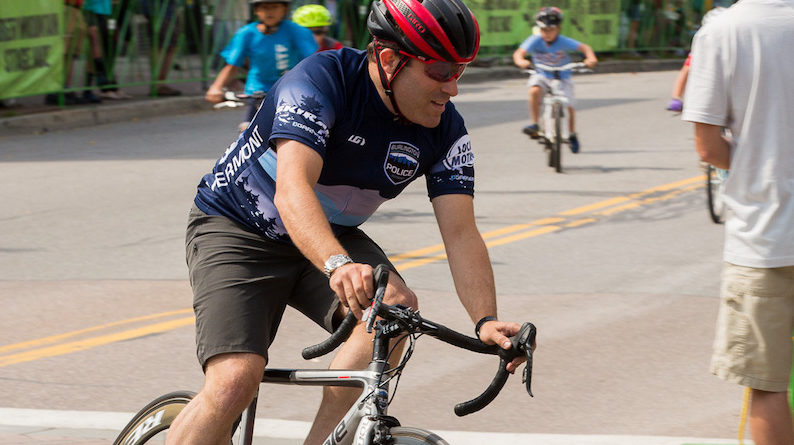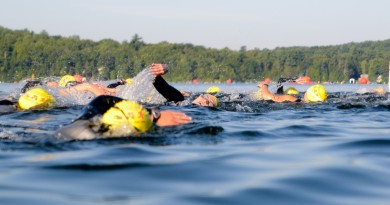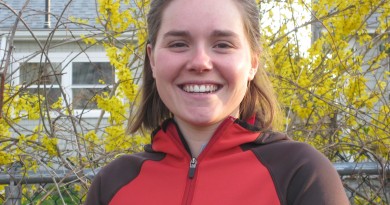The Police Chief Triathlete
Name: Brandon del Pozo Age: 45 From: Brooklyn, N.Y. Lives in: Burlington Family: Wife, Sarah Carnevale; Sons Rex, 6 and Zane, 11. Occupation: Burlington Police Chief Primary sports: Triathlon, rock and ice climbing
Since becoming Burlington’s Police Chief in 2015, Brandon del Pozo has earned a reputation for his progressive stances on policework and the opioid crisis in Vermont. But when he’s not in uniform, you can find him rock or ice climbing in Smugglers’ Notch, teaching his sons to rock climb, chasing his wife on long bike rides and doing triathlons. A Dartmouth grad with a Masters in Public Administration from Harvard, he’s currently working on his Ph.D. in Philosophy and coming back from a serious injury he suffered last summer, when he crashed on his bike in Lake Placid while training for a half Ironman.
You’re a triathlete, a skier, an ice climber, a hiker—what do you consider to be your main sport and why?
I love to ride my bike, but I’ve never been one of those people who spends the winter in the basement on a trainer. To me, that’s when it just makes sense to be out skiing. In the fall, I do a little rock climbing and cyclocross. In the winter, I ice climb and I ski.
I think of myself as an endurance athlete. I get a lot of joy from being at something for hours that requires technical mastery.
What do you love about recreating in Vermont?
I enjoy being seasonal and I’m trying to raise kids with that sense that your athletic life has those rhythms. Vermont has terrain and scenery that supports that: hiking, rock climbing and riding your bike in the summer and ice climbing, skiing and hiking in the winter. On a bike, whether you’re riding mountain gaps or going north to south, you can put mileage on and never get tired of what you’re seeing.
What do you like about triathlons and how many have you raced in?
I really like the idea that even the shortest triathlon requires you go full tilt for over an hour. When I was a young cop in the 1990s, I didn’t have the patience for endurance. I started in earnest in 2009 when my wife got into it. She’s a really excellent triathlete.
I’ve now done a couple dozen Olympic and sprint triathlons, as well as one half Ironman in Lake Placid, which involves a 1.2-mile open water swim, a 56-mile bike ride and a 13.1- mile run. One of my favorite races is the Colchester Triathlon. I love that the whole community turns out to have fun, and anyone can line up with some really talented athletes.
What’s your strongest leg?
I’m a cyclist through and through. The running leg is just the punishment you pay for a nice swim and bike ride. I also love how committing the open water swim can be when you’re out there in a crowd of elbows and feet.
You were in a bike crash in June 2018 that put you in the Intensive Care Unit. What happened?
I was training for a half Ironman and was about 51 miles in to a 56-mile training ride in the Adirondacks. I was coming down Cascade Pass to that beautiful view and I got the speed wobbles when I hit about 45 miles per hour. I was riding a used bike and I’d never gotten it up to that speed before. My last memory was of coming up out of the aero position and saying calmly, “I have to slow this bike down.” I woke up 15 or 20 minutes later with a vague memory of being embarrassed that I was blocking the road. A couple kindly sat with me in the back of their car while the ambulance came, and a Forest Ranger friend asked me if I knew who he was. I didn’t at first, but then my phone rang and he picked it up and said, “Brandon, it’s your wife. I’m going to answer this for you.”
What were your injuries? Had you ever experienced something like that before?
I first went to the Adirondack Medical Center in Saranac Lake and was airlifted then to Burlington, where I was treated in the intensive care unit. I got back to work full time on Aug. 20, two months after the accident.
I’d never had an accident like this before. I snapped my patellar tendon on Camel’s Hump almost ten years ago, but that’s about it.
I wound up with 10 broken bones on my left side, including four ribs, a fractured skull, a partially collapsed lung and a concussion. I kept my helmet, which saved my life, in my office. It’s cracked clean through in a couple places and you can see where it compressed. That lines up with where I fractured my skull.
What was it like to get back on your bike after something like that? Did it change the way you ride or work out?
I knew I had to get back on a bike and I did a few weeks after the accident. It was hard. This fall, I did a lot of gravel riding. I wanted my body to heal before getting back on the road and going really fast. That was great! You can really punish yourself going uphill.
I skied this winter and was fortunate to be able to work with a personal trainer twice a week along with physical therapy right after the accident. Both have helped me make huge gains in power and flexibility.
When do you plan to hit the road and what are your goals this summer?
I got back on my bike seriously for the first time in almost a year the second week in April. It was amazing. I’m planning to do the Colchester Triathlon on July 28 and am training for a half Ironman in Lake Placid in September.
I’m really looking forward to getting back out with the Green Mountain Bicycle Club for their Wednesday night rides. They’re serious about road etiquette, but it’s a really supportive community. But the thing I’m most looking forward to is leading the Green Mountain Stage Race’s Richard Tom Kids’ Crit in downtown Burlington on Labor Day. I’ve done that for the last four years (except last year) and it’s great to see kids that are six, seven, eight years old discover the joy of racing on bikes. Someday I’m sure one of them is going to beat me. I’d be lying if I said I’m not a little worried about that.
How did you go from growing up in Brooklyn to being a mountaineer?
When I was applying to colleges in the early 1990s, New York was a pretty crime-ridden place. At 17, the idea of spending four years in a bucolic place like New Hampshire was pretty compelling. When I was accepted at Dartmouth I fell in love with hiking in the two surrounding mountain ranges: the Green Mountains in Vermont and the White Mountains in New Hampshire.
After graduation, I joined the New Hampshire Army National Guard. I was working for NYPD and living in New York City, but I loved training up at the Mountain Warfare School in Jericho, Vt. That was what turned me on to climbing rock and ice. I took both the summer and winter courses they offer to earn my Ram’s Head Device [a special skill badge that certifies members of the armed forces who have undergone training in mountain warfare]. I ended my career as a course developer for the Vermont Army National Guard in 2004.
How do you feel that experience shaped you as an athlete?
That was what really turned me on to climbing ice and rock and it gave me a great community of people to go out and practice and learn with. I also learned to ski there. They put us all on ancient randonnee gear with leather boots and sent us out touring in the Green Mountains. I loved it. My friends joke that it took me 21 years to get a real ski setup. I still love the idea that you could have one pair of skis that you use to do everything: ski the trees, the resort, tour.
I really get a kick out of striving for technical mastery in the things I do. I’d rather climb at a lower grade with finesse than push myself beyond my limits. The same goes for skiing. I’m all about fine-tuning and improving my turns in technical terrain over ripping down the groomers.
How hard do you climb and what are your favorite spots in Vermont?
I keep it pretty mellow and am more focused on teaching my kids to climb than pushing grades these days. I don’t lead above my ability, where I think I could fall and tend to stick with 5.7s when climbing trad. On ice, I love a good gully climb in Smugglers’ Notch. I’ll lead WI4 on ice. Some of my favorite climbs in Vermont are Hidden Gully and Elephant Head Gully. To look up at those cliffs from the Notch road in the winter and say, “I was up there,” just gives you such a close connection to that place.
Last winter, I had a day in the Adirondacks that was really amazing. I skied to Avalanche Lake with my ice climbing gear, stowed my skis on my pack and climbed the Trap Dyke on Mt. Colden, then made the descent on skis. That was the perfect adventure in my mind, but I’d gladly sacrifice intensity to spend the day outside with my kids.
Ever had to use your mountaineering skills as a cop?
I’ve climbed through a few windows and onto some sketchy roofs here and there but the biggest way I use them is to stay mentally fit. When you’re leading a climb, the whole world exists right in front of you. I really value that, juggling my job, life and family.
Policing is a stressful job. As chief, you have to make difficult decisions every day that affect people’s lives. Being physically fit helps you stay mentally fit. It’s great to live in a place where you can do a sport any season of the year in a world-class environment. That helps you cope with the challenges of policing on a day-to-day basis.
What is your proudest athletic accomplishment?
When I was in my 20s working as a cop on the streets in New York, I never lost a foot pursuit. That’s something I’m still proud of. One time, I even ran down a guy who was on a bike. I think those days are behind me, but I still strive to be a well-rounded athlete.




Cool Chief